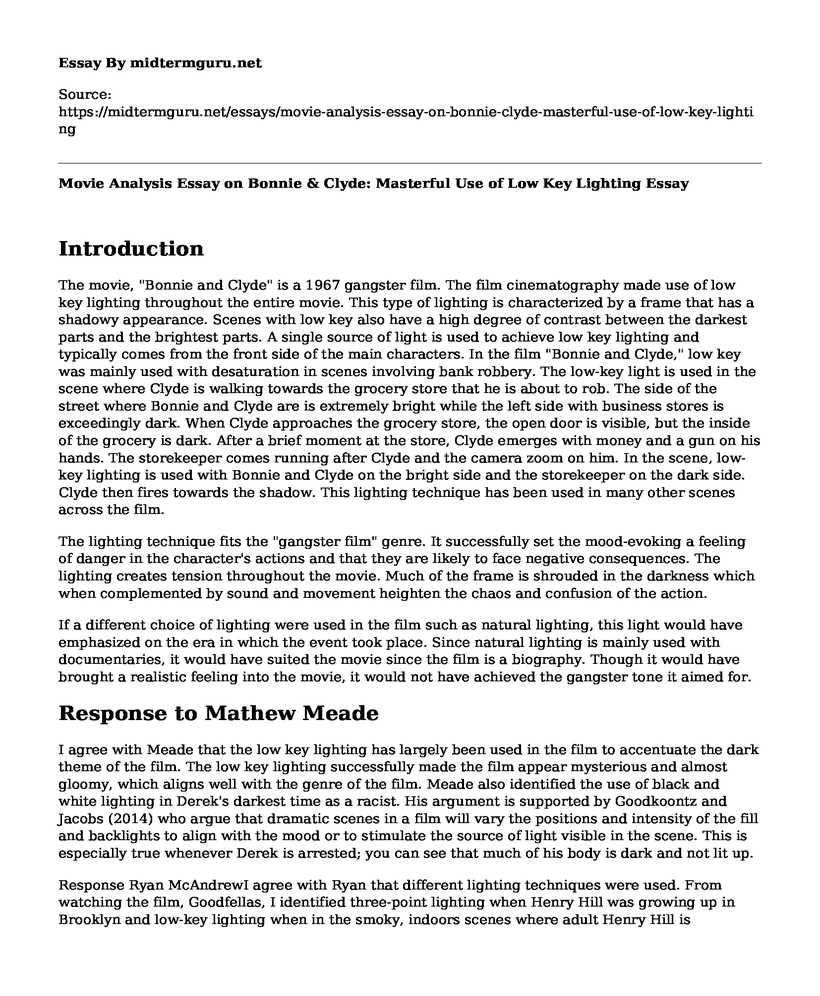Introduction
The movie, "Bonnie and Clyde" is a 1967 gangster film. The film cinematography made use of low key lighting throughout the entire movie. This type of lighting is characterized by a frame that has a shadowy appearance. Scenes with low key also have a high degree of contrast between the darkest parts and the brightest parts. A single source of light is used to achieve low key lighting and typically comes from the front side of the main characters. In the film "Bonnie and Clyde," low key was mainly used with desaturation in scenes involving bank robbery. The low-key light is used in the scene where Clyde is walking towards the grocery store that he is about to rob. The side of the street where Bonnie and Clyde are is extremely bright while the left side with business stores is exceedingly dark. When Clyde approaches the grocery store, the open door is visible, but the inside of the grocery is dark. After a brief moment at the store, Clyde emerges with money and a gun on his hands. The storekeeper comes running after Clyde and the camera zoom on him. In the scene, low-key lighting is used with Bonnie and Clyde on the bright side and the storekeeper on the dark side. Clyde then fires towards the shadow. This lighting technique has been used in many other scenes across the film.
The lighting technique fits the "gangster film" genre. It successfully set the mood-evoking a feeling of danger in the character's actions and that they are likely to face negative consequences. The lighting creates tension throughout the movie. Much of the frame is shrouded in the darkness which when complemented by sound and movement heighten the chaos and confusion of the action.
If a different choice of lighting were used in the film such as natural lighting, this light would have emphasized on the era in which the event took place. Since natural lighting is mainly used with documentaries, it would have suited the movie since the film is a biography. Though it would have brought a realistic feeling into the movie, it would not have achieved the gangster tone it aimed for.
Response to Mathew Meade
I agree with Meade that the low key lighting has largely been used in the film to accentuate the dark theme of the film. The low key lighting successfully made the film appear mysterious and almost gloomy, which aligns well with the genre of the film. Meade also identified the use of black and white lighting in Derek's darkest time as a racist. His argument is supported by Goodkoontz and Jacobs (2014) who argue that dramatic scenes in a film will vary the positions and intensity of the fill and backlights to align with the mood or to stimulate the source of light visible in the scene. This is especially true whenever Derek is arrested; you can see that much of his body is dark and not lit up.
Response Ryan McAndrewI agree with Ryan that different lighting techniques were used. From watching the film, Goodfellas, I identified three-point lighting when Henry Hill was growing up in Brooklyn and low-key lighting when in the smoky, indoors scenes where adult Henry Hill is conversing with the wise guy cohorts. The lighting shows different times as well as aligning the film with the gangster film genre. The use of low key lighting also reflects well with the mob lifestyle of the characters.
References
Goodykoontz, B., & Jacobs, C. P. (2014). Film: From watching to seeing (2nd ed.). San Diego, CA: Bridgepoint Education, Inc.
Penn, A. (1967, September 11). Bonnie and Clyde (1967). Retrieved from https://www.imdb.com/title/tt0061418/
Cite this page
Movie Analysis Essay on Bonnie & Clyde: Masterful Use of Low Key Lighting. (2023, Jan 20). Retrieved from https://midtermguru.com/essays/movie-analysis-essay-on-bonnie-clyde-masterful-use-of-low-key-lighting
If you are the original author of this essay and no longer wish to have it published on the midtermguru.com website, please click below to request its removal:
- Essay on Spider Man 2
- How Bell Hit Bottom Los Angeles Times Article Review Example
- Paper Example on Smartphone Technology as Media Access Tools
- Essay Sample on Theme of AIDS in Movies: Dallas Buyers Club and the Philadelphia
- Couples Conflict: TV vs. Online Gaming - Essay Sample
- Unlock the Power of Social Media: Connecting the World - Essay Sample
- Movie Analysis Essay on The Dark Knight







